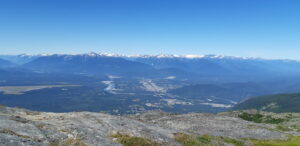Terrace, British Columbia
July 28, 2023 By: Clarissa Wight
Location: Terrace, British Columbia

I live in Terrace, British Columbia. I have lived here all my life and the area has changed drastically within that time but even more so since the first people lived in the area at least 5,000 years ago. It has been gradually growing and expanding but the rate of growth has increased in the past few years due industries expanding in surrounding towns that Terrace provides some essential services for and the construction of a new hospital.
Terrace is located on Tsimshian territory. According to the Canadian Encyclopedia, their connection to the land dates back at least 5,000 years (Powell). This is based on archaeological findings in neighboring Prince Rupert. The area’s Indigenous cultural is well known for its beautiful artwork including totem poles. The Tsimshian’s food sources include fish and trapping.
Situated on the Skeena River, the Tsimshian had an abundance of fish. It is a major river that sustains fish, wildlife, and vegetation. At 580 km long, it is the second largest river that is located entirely within BC. More recently, it has been popular for salmon and steelhead sport fishing by locals as well as Europeans. However, due to a depleting fish population, the river has been closed to fishing the past few of seasons, with the exception of Indigenous fishers. It has become more common for conservation efforts to limit fishing to help the population increase. In addition to providing a source of food for people, the fish are also a vital food source for the local bear population.
Settlers arrived in the area in the late 1800s. According to the City of Terrace website, the city’s founder, George Little, acquired 435 acres of land between 1907 and 1911 which includes the current downtown area (City of Terrace). Soon after, the Grand Truck Pacific Railway connected Terrace with the west and the population increased. The arrival of the Army and Royal Canadian Air Force during World War II stimulated further growth. With the connection of highway 16 and the industrial fluctuations, the population has gradually increased to the approximate 12,000 cited on the 2021 census (Government of Canada, Statistics Canada). The population in the districts and reserves surrounding Terrace adds another approximately 6,000 people.
From its inception, Terrace’s staple economy has been logging. Many lumber and pulp mills in the area have opened and closed since settlers first arrived. Another contribution to the local economy was fruit production. Particularly in the low-lying areas near the Skeena River, several orchards were developed. As the population of Terrace has increased, these areas have been subdivided into city lots with a handful of small apartment complexes also in the area.
Similarly on the north side of town, lots have become smaller and smaller. Terrace gets it’s name from the terraced landscape carved out by glacier movement during the last ice age. The locals refer to the upper area as ‘the bench.’ When I was growing up, my parents’ house was one of only a few in their neighbourhood on the bench. Now, it is surrounded by multiple subdivisions that have gradually divided up farmland and forested areas. The number of trees that have been logged in the area is substantial due to the developments.
A noticeable impact from the deforestation as the city pushes out is the disappearing wildlife. Our family has raised chickens since I was young. It was common to see fox, bears and even moose near our home as they were attracted to the chickens. As more houses have been built, animal encounters have decreased incredibly. Although their populations may not be majorly affected, their immediate habitat has been destroyed.
Another change to the environment with the arrival of humans has been plant species from Europe brought with them. According to the City of Terrace website, some invasive species in the area include Scotch thistle, Japanese knotweed, common burdock, chicory, English ivy, Gorse, and Giant hogweed (City of Terrace). A quick search of these species shows their origins as Europe with some origination from Asia. In the city’s instructions on how to dispose of them, it explicitly says to not put them in the city compost bins as it would lead to their further spread.
Although people have lived in the area for thousands of years, the most significant environmental impacts have occurred since the arrival of settlers.
Bibliography
City of Terrace. “Terrace History.” Accessed July 27, 2023. https://www.terrace.ca/culture-heritage/city-heritage/history.
Government of Canada, Statistics Canada. “Census Profile, 2021 Census of Populationprofile Table.” Profile table, Census Profile, 2021 Census of Population – Terrace, City (CY) [Census subdivision], British Columbia, February 1, 2023. https://www12.statcan.gc.ca/census-recensement/2021/dp-pd/prof/details/page.cfm?Lang=E&SearchText=Terrace&DGUIDlist=2021A00055949011&GENDERlist=1&STATISTIClist=1&HEADERlist=0.
Powell, J. V. “Ts’msyen (Tsimshian).” The Canadian Encyclopedia, November 17, 2010. https://www.thecanadianencyclopedia.ca/en/article/tsimshian.